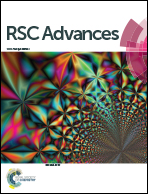Root system of live plants is a powerful resource for the green synthesis of Au-nanoparticles†
Abstract
Sixteen plant species from 11 distinct families were evaluated for their potential to exogenously fabricate Au-nanoparticles (NPs) at the root surface. The root system of intact plants of all species turned clear pale yellow colloidal salt solutions of Au purple/golden. Transmission electron microscopy coupled with energy dispersive X-ray spectroscopy revealed the presence of Au-NPs in the range of 5–100 nm in these colloidal solutions. PXRD showed the crystalline nature of Au-NPs. Reduction of 2,6-dichlorophenol-indophenol (DCPIP) by the root system of intact plants confirmed that the root surface possesses the strong reducing strength necessary for the reduction of Au3+ to Au0 and to generate Au-NPs. Our findings unequivocally demonstrated for the first time that roots of intact plants of certain species can be exploited for the bulk synthesis of Au-NPs exogenously under ambient conditions in an aqueous phase. These findings highlight a novel, simple, economically feasible and green/eco-friendly scheme for the exogenous production of Au-NPs in an aqueous phase under ambient conditions.


 Please wait while we load your content...
Please wait while we load your content...